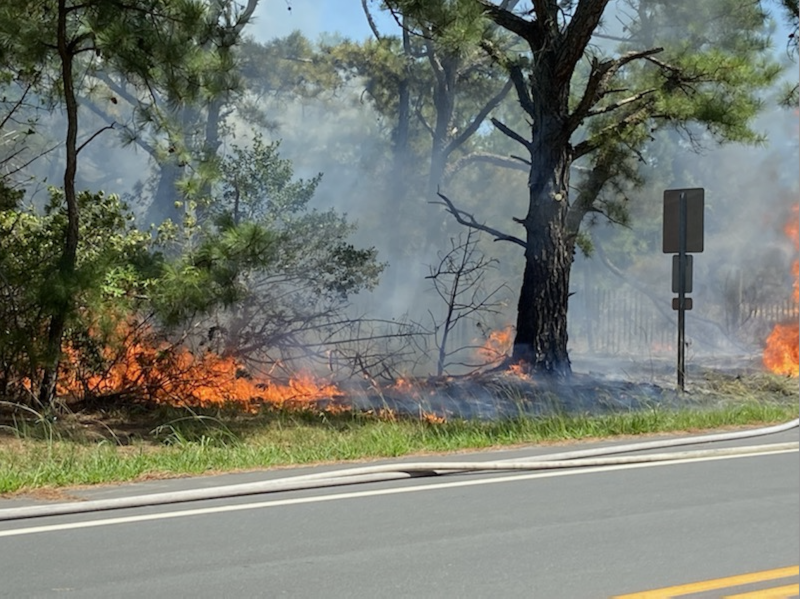Recent area weather conditions ignite wildfire concerns

Delaware’s ongoing drought and the current weather conditions the state has been experiencing have caused an uptick in wildfires in all three counties. Due to an elevated wildfire risk, the Delaware Forest Service urges all residents to refrain from outdoor burning.
The National Weather Service, in collaboration with state wildfire supervisors, recently issued a special weather statement indicating an elevated fire risk due to dropping humidity levels and high winds across the region, including Delaware.
“Most people think of the summer as being the most dangerous time for wildfires, but in Delaware, the period of leaf drop in the fall and right now, when vegetation is dormant and the fine fuel moisture is low, is when we see the most wildfires,” said State Forester Kyle Hoyd. “This is the worst I have seen for fine fuel issues in my 20 years with the Delaware Forest Service. Just last week, we fought a wildfire where there was crown torching on 30- to 50-foot-high trees. We need residents to take this request seriously for their safety, as well as their neighbors and their communities.”
Fine fuel moisture refers to the moisture content of small, easily ignited fuels like grass, leaves and twigs. Since vegetation is dormant, even with the rain Delaware experienced last week, the grass, brush and trees cannot absorb the water as they do later in spring when green-up and growth occur. This dormancy creates a situation where grass, leaf litter and pine needles can easily combust.
All of Delaware continues to be impacted by the drought. According to the U.S. Drought Monitor, 46.4% of Delaware is in a moderate drought, with the remaining 53.6% experiencing severe drought conditions. Crown torching traditionally has not been a problem in Delaware, but fire looks for available fuels. Trees went into dormancy last fall with a severe water shortage, and combined with low humidity levels throughout winter, they have created another fuel source.
Delaware Wildland Fire Supervisor Sam Topper said, “This is a phenomenon that the Northeast hasn’t experienced until just recently, and unfortunately, if this drought cycle doesn’t break soon, we are going to continue to see an increase in wildfire activity – and not just the surface fires we typically battle.”
From November 2024 through February 2025, Delaware has experienced more than 420 outdoor fires across the state. With expertise in wildland fire, the Delaware Forest Service engaged in 15 of these incidents. On average, from 2020 to 2023, the Delaware Forest Service responded to five wildfires a year, but it responded to 22 wildfires in 2024.
“With the increased response needed right now, we have staff on call around the clock, maintaining equipment and responding to the scenes when our assistance is requested,” said Topper. “When you look at the increase in wildfire activity over the past five years, with the calls really hitting hard in 2024 and already high this year, there is a real concern on how our small staff can continue to operate at these levels statewide. If this is the new norm, we need the Delaware Forest Service to be fully staffed and have updated working equipment to protect our staff in larger fires.”
Typically, wildfires in January and February have not escalated to the level where local fire companies seek out the expertise of the Delaware Forest Service. The experts are very concerned, as the peak spring wildfire season for Delaware is from mid-April to the beginning of May, and staff have already responded to two fires each month and four in March. These trends and the ongoing drought do not look to end anytime soon, necessitating warning residents and visitors about the safety concerns of outdoor burning.
For more information, go to agriculture.delaware.gov/forest-service/wildland-fire/.
Creating defensible space around the home
The Delaware Forest Service encourages Delawareans to create a defensible space around their homes as a safety buffer from wildfires. The goal of defensible space is to slow or stop wildfire spread while protecting homes and providing firefighters with a safer area to fight wildfire.
From the home to 5 feet away from the structure, residents should:
• Clear the roof and gutters of dead leaves, pine needles, and debris
• Replace or repair loose or missing shingles to prevent embers from gaining access to the roof
• Remove any flammable materials, including mulch, flammable plants, leaves, pine needles and firewood piles, from the home’s exterior walls
• Prevent the build-up of combustible materials from collecting under stairs, decks, and porches.
From 5 to 30 feet away from the structure:
• Remove vegetation under trees so a surface fire cannot reach the crowns of trees
• Clear vegetation from under large stationary propane tanks
• Keep lawns and native grasses mowed to a height of four inches or less
• Ensure that when fully mature, no tree canopy is closer than 10 feet to the edge of a structure
• Place trees and shrubs in small clusters to minimize the continuity of vegetation in the landscape
• Utilize driveways, sidewalks, patios, and decks to create a fuel break.















































